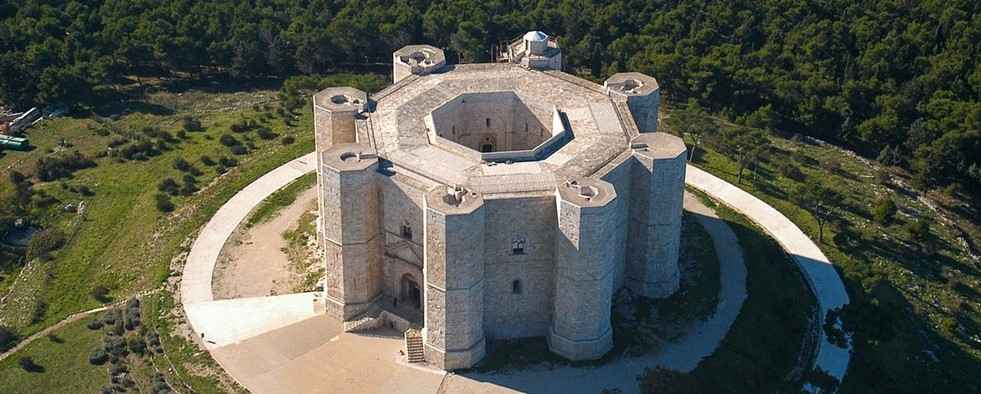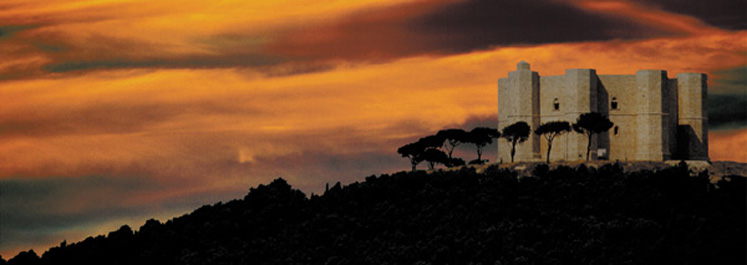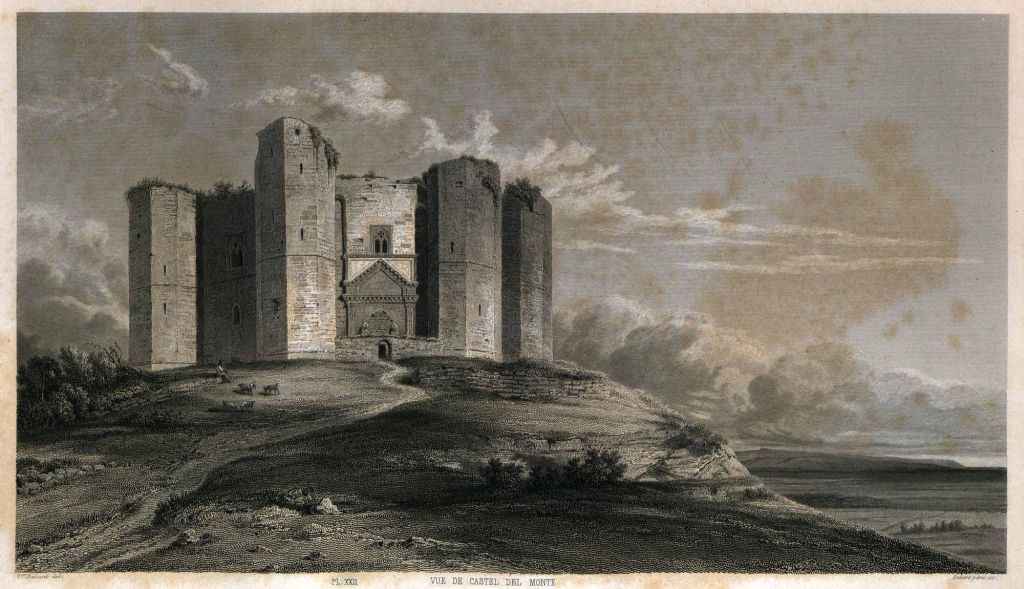




 Universally known for its unmistakable octagonal shape, for its symbolic suggestions and for being - according to many - the most mysterious of the buildings commissioned by Frederick II of Svevia, Castel del Monte is one of the main tourist destinations in Puglia. A castle where perhaps the emperor never stayed but where, paradoxically, the collective imagination feels its looming presence more than anywhere else.
Universally known for its unmistakable octagonal shape, for its symbolic suggestions and for being - according to many - the most mysterious of the buildings commissioned by Frederick II of Svevia, Castel del Monte is one of the main tourist destinations in Puglia. A castle where perhaps the emperor never stayed but where, paradoxically, the collective imagination feels its looming presence more than anywhere else.
Approaching the site, the castle emerges in a spectacular solitude dominating, from the height of its 540 meters above sea level, a vast area of Puglia and Basilicata. Today as never before, the castle poses specific questions aimed at restoring its role, especially within the historical and territorial context, however not avoiding the complex symbolic universe linked to knowledge and power represented by Frederick II. The open questions on which historians have been discussing in recent times (documents in hand), concern above all the historical moment and the reasons for its construction, the reasons linked to the choice of the site, the evaluation of all those elements - not always of immediate perception - that allow to unequivocally recognize the function of castrum as primary with respect to other possible ones. Castel del Monte is therefore first of all a medieval castle, with multipurpose functions, to be read within the organic castle system created by Frederick II of Svevia to govern the territory, and to be analyzed in its relations with the main castles in the area, that is, those of Barletta, Canosa, Trani, but also of Andria, Ruvo, Corato, Terlizzi, Bari and Gravina.
 On January 29, 1240, from Gubbio, Emperor Frederick II signed a decree directed to Riccardo di Montefuscolo, executioner of Capitanata, in which he ordered to prepare the necessary material for the construction of a castle located at the church (now disappeared) of Sancta Maria de Monte. At the time, its construction must have already reached the roofs, and therefore be close to completion.
On January 29, 1240, from Gubbio, Emperor Frederick II signed a decree directed to Riccardo di Montefuscolo, executioner of Capitanata, in which he ordered to prepare the necessary material for the construction of a castle located at the church (now disappeared) of Sancta Maria de Monte. At the time, its construction must have already reached the roofs, and therefore be close to completion.
In fact, other sources inform that in 1246 Manfredi, son of Federico, imprisoned some rebel subjects in the castle, and that in 1249 there were celebrations for the wedding of Violante, natural daughter of the emperor, with Riccardo count of Caserta. In a navigation manual composed around 1250, known as "Compasso de Navigare", "una montagna longa enfra terra et alta, e la dicta montagna se clama lo Monte de Sancta Maria, et à en quello monte uno castello" (ancient Italian: a high and long mountain over the land and the name of such mountain is Saint Mary mountain and on this mountain there is a castle) as if the building, visible in the coastal stretch between Trani and Barletta, was a reference point now acquired by navigation. In any case after 1268, at the fall of the Swabians, Charles I of Anjou would have imprisoned Federico, Enrico and Enzo, sons of Manfredi. Furthermore, with the interventions promoted by him starting from 1277, the function of sighting and control of the territory that the castle already carried out in the Swabian age is strengthened: the sign and function of Castel del Monte as an element of a communication system also visual they are therefore confirmed and strengthened.
 Except for short periods of celebrations (wedding between Beatrice d'Angiò and Bertrando del Balzo in 1308, and between Umberto de la Tour, dolphin of France, and Maria del Balzo in 1326), the castle remained mostly used as a prison. Ferdinand of Aragon stayed there in 1495, before being crowned king of the two Sicilies in Barletta. The current name of the castle appears a little later in a decree of the same king, issued at Altamura. Annexed to the Duchy of Andria, it belonged to Consalvo da Cordova and, from 1552, to the Carafa counts of Ruvo. It was a refuge for many noble Andriean families during the plague of 1656.
Except for short periods of celebrations (wedding between Beatrice d'Angiò and Bertrando del Balzo in 1308, and between Umberto de la Tour, dolphin of France, and Maria del Balzo in 1326), the castle remained mostly used as a prison. Ferdinand of Aragon stayed there in 1495, before being crowned king of the two Sicilies in Barletta. The current name of the castle appears a little later in a decree of the same king, issued at Altamura. Annexed to the Duchy of Andria, it belonged to Consalvo da Cordova and, from 1552, to the Carafa counts of Ruvo. It was a refuge for many noble Andriean families during the plague of 1656.
 Since the eighteenth century, remained unattended, it was systematically devastated, stripped of marble and furnishings, and became a shelter for shepherds, brigands, political refugees. In 1876, before the definitive ruin occurred, the castle was purchased by the Italian state for the sum of £ 25,000, which is really negligible if one thinks that the first necessary recovery interventions practically required an identical figure. The restoration works resumed with continuity and scientific caution from 1928 onwards, up to the most recent interventions of the 1980s.
Since the eighteenth century, remained unattended, it was systematically devastated, stripped of marble and furnishings, and became a shelter for shepherds, brigands, political refugees. In 1876, before the definitive ruin occurred, the castle was purchased by the Italian state for the sum of £ 25,000, which is really negligible if one thinks that the first necessary recovery interventions practically required an identical figure. The restoration works resumed with continuity and scientific caution from 1928 onwards, up to the most recent interventions of the 1980s.
Due to its uniqueness characteristics, UNESCO included it in 1996 in the world heritage of humanity.
 As is known, the structure of the castle basically consists of a monumental octagonal block, on whose eight corners as many towers of the same shape rest. The distribution of the internal space is divided into two floors, each of which has eight trapezoidal-shaped rooms gathered around a courtyard (obviously octagonal). The main façade, on the east side, is dominated by a majestic portal which is accessed by two flights of symmetrical stairs. The compact and severe courtyard, which repeats the layout of the whole building in an octagonal shape, lightens its wall mass only at the three communication portals with the ground floor rooms, and the three French windows corresponding to as many rooms on the upper floor.
As is known, the structure of the castle basically consists of a monumental octagonal block, on whose eight corners as many towers of the same shape rest. The distribution of the internal space is divided into two floors, each of which has eight trapezoidal-shaped rooms gathered around a courtyard (obviously octagonal). The main façade, on the east side, is dominated by a majestic portal which is accessed by two flights of symmetrical stairs. The compact and severe courtyard, which repeats the layout of the whole building in an octagonal shape, lightens its wall mass only at the three communication portals with the ground floor rooms, and the three French windows corresponding to as many rooms on the upper floor.
 Three are the building materials used in the castle; their combination and distribution in the building are not random and play an important role in our color perception. First of all the local limestone, white or pinkish depending on the times of the day and weather conditions, predominant because it affects the architectural structures as a whole and some decorative details; the marble, white or slightly veined, now surviving in the precious windows of the first floor and in the decoration of the rooms, but which originally was to constitute a large part of the furnishings of the castle; finally the coral breach, a color note used in the decoration of the rooms on the ground floor and in the finishing of doors and windows, internal and external, as well as in the main portal; a precious and lively effect made by a conglomerate of red earth and limestone cemented with clay still available in quarries in the surrounding area.
Three are the building materials used in the castle; their combination and distribution in the building are not random and play an important role in our color perception. First of all the local limestone, white or pinkish depending on the times of the day and weather conditions, predominant because it affects the architectural structures as a whole and some decorative details; the marble, white or slightly veined, now surviving in the precious windows of the first floor and in the decoration of the rooms, but which originally was to constitute a large part of the furnishings of the castle; finally the coral breach, a color note used in the decoration of the rooms on the ground floor and in the finishing of doors and windows, internal and external, as well as in the main portal; a precious and lively effect made by a conglomerate of red earth and limestone cemented with clay still available in quarries in the surrounding area.
Originally the role played by color had to be even more decisive: all the rooms had to be covered with slabs (in red breach on the ground floor, marble to the upper one); the breach gave chromatic emphasis to the fireplaces, jambs, door and window profiles, the mosaic illuminated not only the flooring but also the vaults of the rooms. Perhaps a painted decoration embellished the walls of the rooms on the first floor.
A string course surrounds the entire building, marking the presence of the two floors of the building, each divided into eight rooms corresponding to the eight sides of the octagon. Each wall of the castle between two towers has two windows (not always in axis with each other): a round single-lancet window at the lower floor (except on the two opposite sides east and west, occupied respectively by the main portal and the entrance of service, and a mullioned window on the upper floor (except on the north side, the one in the direction of Andria, opened with a mullioned window).
Numerous narrow loopholes open on the towers, variously arranged and deeply splayed, which give light to the internal spiral stairs, to the services and to the rooms of the towers themselves. On the west side, the one opposite the main entrance, we find the secondary entrance, consisting of a simple arched profile, without any decoration. A detail worthy of note concerns the mullioned window between towers 7 and 8 which retains - in the right niche - the only surviving mosaic tile (green) of the polychrome window decorations. On the main front of the castle two flights of symmetrical stairs rebuilt in 1928 rise towards the main portal in coral breach, in which slender and grooved pillars, with Corinthian capitals, support a fake architrave shaped at the bottom by modiglioni, on which a tympanum is set cuspidato, all constitutive elements that undoubtedly suffer from sources of classical inspiration. Between the external and internal part of the access compartment there is the cavity functional to the sliding of the shutter that was operated from the above "throne room".
 Each of the two floors of the building includes eight trapezoidal rooms, all of similar size, but characterized by a subtle hierarchy depending on how they communicate with each other or with the internal courtyard. Generally you can find more "comfortable" rooms, equipped with some accessories (such as high fireplaces, or hallways and toilets placed in the towers), and passage rooms, equipped with independent paths with respect to them.
Each of the two floors of the building includes eight trapezoidal rooms, all of similar size, but characterized by a subtle hierarchy depending on how they communicate with each other or with the internal courtyard. Generally you can find more "comfortable" rooms, equipped with some accessories (such as high fireplaces, or hallways and toilets placed in the towers), and passage rooms, equipped with independent paths with respect to them.
The problem of covering trapezoidal rooms is solved impeccably: the trapezoid is broken down into a central square, the side of which corresponds to the wall of the room towards the courtyard, and two lateral triangles; the central square part is vaulted with a ribbed cross, the two triangles from half-barrels to an ogive.
 The use of the ribs, already widespread in France for a long time, is a novelty in Puglia: but here, both in the ground floor and in the upper floors, they have no static function; their decorative purpose is underlined by the presence of a figured keystone, different in each room, among which the seventh room on the ground floor stands out for its originality (depicting a faun's head, with pointed and protruding ears, framed by grapes and pampini), and those of the seventh and eighth rooms on the upper floor (respectively animated by four human heads and four knotted hybrids). Also on the upper floor, in the so-called "throne room", the keystone represents a bearded human face, interpreted now as a faun, now as an astrologer, magician or even a philosopher.
The use of the ribs, already widespread in France for a long time, is a novelty in Puglia: but here, both in the ground floor and in the upper floors, they have no static function; their decorative purpose is underlined by the presence of a figured keystone, different in each room, among which the seventh room on the ground floor stands out for its originality (depicting a faun's head, with pointed and protruding ears, framed by grapes and pampini), and those of the seventh and eighth rooms on the upper floor (respectively animated by four human heads and four knotted hybrids). Also on the upper floor, in the so-called "throne room", the keystone represents a bearded human face, interpreted now as a faun, now as an astrologer, magician or even a philosopher.
 On the ground floor, the plan of the central square compartment is highlighted even more by the four powerful half-columns that delimit it laterally, which, like the respective capitals decorated with curved apex leaves, the round window frames, the oculi and the thresholds between one room and another are all in coral breach. The abacus of the capitals runs over the entire wall, framing doors and windows, and highlighting the roof tax line; up to this level, originally, the walls must also have been covered with rubble. Of the original flooring of the rooms, with geometric inlays in white marble and slate, few fragments remain in the eighth room.
On the ground floor, the plan of the central square compartment is highlighted even more by the four powerful half-columns that delimit it laterally, which, like the respective capitals decorated with curved apex leaves, the round window frames, the oculi and the thresholds between one room and another are all in coral breach. The abacus of the capitals runs over the entire wall, framing doors and windows, and highlighting the roof tax line; up to this level, originally, the walls must also have been covered with rubble. Of the original flooring of the rooms, with geometric inlays in white marble and slate, few fragments remain in the eighth room.
Also on the ground floor, only three rooms communicate directly with the internal courtyard, determining from the outset a series of "obligatory paths" that help define a sort of hierarchy between the various environments that we perceive as all the same. Each wall of the courtyard (which is octagonal in respect of the octagonal plan of the building) ends at the top with a pointed arch arch set on corner pilasters; the lightening of the building masses is given by the doors and windows that open there, of various shapes and without a precise distribution, according to the needs of the interior. On the upper level there are three French windows in coral breccia, with architrave on shelves, framed by two columns that hold an archivolt decorated with leaves and ovules. We can reasonably think that originally these French windows - and therefore the relative rooms - communicated with each other through a wooden hanging path that ran along the entire perimeter of the courtyard.
 Access to the upper floor is via two of the eight towers, equipped with a spiral staircase. One is tower 3, also called Torre del Falconiere, communicating with the fourth room and covered by a tripartite vault supported by anthropomorphic shelves depicting one a faun head, the other a female face; the other is tower 7, accessible from the eighth room, covered by an exaparted vault supported by telamons in curious and provocative attitudes. Tower 5, on the other hand, has the only practicable staircase to the terrace without interruption: its "service" function is so much suggested to be accessible from the fifth room (the one located on the opposite side to the main one, communicating with the outside thanks to a secondary door, now walled), as to the singularity of the fact that, at the height of the upper floor, in addition to the direct passage to the fifth room, there is another passage moved to the left that allows you to continue up to the roof without going through the hall. The terrace is a privileged observation point: the view can range from the Murge to the Tavoliere up to the Gargano and the Vulture, leaving space, in the clearest days, even to the cities of the Earth of Bari.
Access to the upper floor is via two of the eight towers, equipped with a spiral staircase. One is tower 3, also called Torre del Falconiere, communicating with the fourth room and covered by a tripartite vault supported by anthropomorphic shelves depicting one a faun head, the other a female face; the other is tower 7, accessible from the eighth room, covered by an exaparted vault supported by telamons in curious and provocative attitudes. Tower 5, on the other hand, has the only practicable staircase to the terrace without interruption: its "service" function is so much suggested to be accessible from the fifth room (the one located on the opposite side to the main one, communicating with the outside thanks to a secondary door, now walled), as to the singularity of the fact that, at the height of the upper floor, in addition to the direct passage to the fifth room, there is another passage moved to the left that allows you to continue up to the roof without going through the hall. The terrace is a privileged observation point: the view can range from the Murge to the Tavoliere up to the Gargano and the Vulture, leaving space, in the clearest days, even to the cities of the Earth of Bari.
 The roofing of the terrace was redone during the last restoration works: it consists of a double slope, of which the internal one, by means of lead pipes embedded in the masonry, aimed at conveying the water to the cistern of the courtyard, and the one outside the pipes of the services of the towers. The structure and distribution of the rooms on the upper floor follow that of the ground floor, but express greater refinement in the decorative details and in the overall architecture. The ribs that support the vaults are thinner and slender, and start from tristile marble columns joined together in a bundle by a single capital elegantly decorated with plant motifs. On the side that leads to the outside, each room is brightly lit by a mullioned window with a clear Gothic flavor (the only exception, a triple-lancet window second room, on the northern side of the castle); characteristic of these large windows is the fact that they are raised by steps and flanked by seats. On the courtyard side, depending on the halls, French windows and round single-lancet windows alternate. Along the walls of each room there is a marble seat under the base of the columns, and a string course frame with the vaulted shutter. Originally the walls of these rooms had to be completely covered with large marble slabs
The roofing of the terrace was redone during the last restoration works: it consists of a double slope, of which the internal one, by means of lead pipes embedded in the masonry, aimed at conveying the water to the cistern of the courtyard, and the one outside the pipes of the services of the towers. The structure and distribution of the rooms on the upper floor follow that of the ground floor, but express greater refinement in the decorative details and in the overall architecture. The ribs that support the vaults are thinner and slender, and start from tristile marble columns joined together in a bundle by a single capital elegantly decorated with plant motifs. On the side that leads to the outside, each room is brightly lit by a mullioned window with a clear Gothic flavor (the only exception, a triple-lancet window second room, on the northern side of the castle); characteristic of these large windows is the fact that they are raised by steps and flanked by seats. On the courtyard side, depending on the halls, French windows and round single-lancet windows alternate. Along the walls of each room there is a marble seat under the base of the columns, and a string course frame with the vaulted shutter. Originally the walls of these rooms had to be completely covered with large marble slabs
A special mention must be made for what is traditionally referred to as the "throne room", located on the eastern side of the building in correspondence with the main elevation, from which it is also possible to maneuver the sliding of the shutter of the access door. Thanks to its location and the suggestion increased by a vast literature on the subject, it is here that the collective imagination places the "mythical" Federico, absorbed, contemplative, engaged in learned consultations with the experts of his court. And it is here, in the "oriented" room of a castle that many intentionally want to face the sun and Christ as the apse of a cathedral, that the link with the celestial and "divine" phenomena, even outside the historical and documentable, it becomes stringent and palpable.
